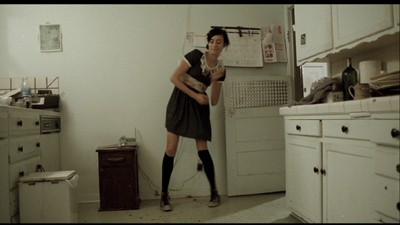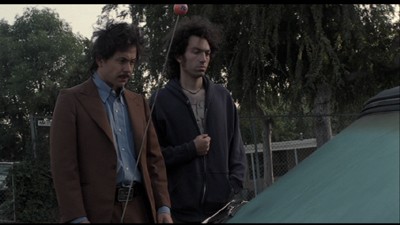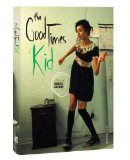| Reviews & Columns |
|
Reviews DVD TV on DVD Blu-ray 4K UHD International DVDs In Theaters Reviews by Studio Video Games Features Collector Series DVDs Easter Egg Database Interviews DVD Talk Radio Feature Articles Columns Anime Talk DVD Savant Horror DVDs The M.O.D. Squad Art House HD Talk Silent DVD
|
DVD Talk Forum |
|
|
| Resources |
|
DVD Price Search Customer Service #'s RCE Info Links |
|
Columns
|
|
|
Good Times Kid, The
Other // Unrated // August 11, 2009
List Price: $24.98 [Buy now and save at Amazon]
 "The GoodTimesKid" is a peculiar film, and it's a lovely sort of peculiar, a bit of homemade punk cinema that challenges expectations as it wins us over with its unusual characters. The film walks a fine line - one wrong step, and all its carefully designed quirkiness would come crashing down in a heap of art house pretension. Yet it keeps its balance throughout, because underneath all its eccentricities, it's a gentle little story about people we want to watch.
"The GoodTimesKid" is a peculiar film, and it's a lovely sort of peculiar, a bit of homemade punk cinema that challenges expectations as it wins us over with its unusual characters. The film walks a fine line - one wrong step, and all its carefully designed quirkiness would come crashing down in a heap of art house pretension. Yet it keeps its balance throughout, because underneath all its eccentricities, it's a gentle little story about people we want to watch.Being one of those indie projects where not much happens in the traditional sense and the story is instead about character interaction peppered with long stretches of introspective not-much, it's understandable that you can spend more time discussing the backstory than the actual plot. Even the set-up is simple: Rodolfo Cano (Azazel Jacobs) enlisted in the Army following a fight with girlfriend Diaz (Sara Diaz, here credited only by her last name) - but the Army's notification found its way to another guy also named Rodolfo Cano (Gerardo Naranjo).
So begins our tale. The Rodolfos meet, sort of, at the recruitment center, where Rodolfo I has decided to renege on the military and Rodolfo II is trying his best to catch up to him to straighten out the whole mess. When Rodolfo I returns home for a birthday party but storms out quickly after (another fight), Rodolfo II finds himself just... lingering. And then he finds himself refusing to leave Diaz's side, which leads her back to his boathouse, where it is possible to learn so much about each other without saying much of anything.
The minimal dialogue leaves you debating every possible motivation, as the screenplay (by Jacobs, who also directed, and Naranjo) adamantly refuses to reveal much. It makes sense. Rodolfo I and Diaz are at that point in their relationship where body language says so much, and besides, after all that fighting, neither really wants to say too much more. Rodolfo II, meanwhile, isn't the type to say much of anything; his English isn't the best, and his little tramp lifestyle keeps him rather introverted.
There's obviously so much more going on in these three lives than what we see in the single night of the story. The film's ending leaves us with questions, the fates of these three people so very uncertain. And it's not just the finale (although the final scenes will leave you thinking and arguing - why did he do this, why did she do that, what will happen next?). The actors are obviously relishing the enigmatic nature of every movement. Is this twitch, that glance a sign of something more?
It's impressive to see how much these three get out of so little. They're able to make the most out of their appearances, their looks saying so much about the characters, saving much unnecessary dialogue. Both Rodolfos are unkempt, almost slovenly, but in different ways - Rodolfo I comes with the disshevled look of a punk rocker, while Rodolfo II's unkempt appearance, with no fashionable accompaniment, just makes him look lost in the world. (Naranjo also lends his character a perpetual glaze to the eyes, even when he's around people he knows.)
Diaz, meanwhile, is a punk pixie - not the carefully designed kind of the Hot Topic crowd, but a more unaffected look that's far more honest. She's the sort of girl who'd be a whimsical charmer if only she could afford the wardrobe. And at times, she lets such optimism shine through: in one highlight, she attempts to cheer up Rodolfo II - whom she just met, whose name she doesn't yet know, whom she calls "Depresso" - with a giddy, wiggly dance set to vintage jazz playing on a turntable. More than just a cute sequence, it also fits perfectly with the storytelling economy of the film; accompanying the very look of her shabby Echo Park house are now clue words like "vintage jazz" and "turntable" that instantly signify who this woman is.
Economy is important to the filmmakers, and not just stylistically. A key selling point of the film is that is was shot on what they're calling "stolen film" - unused, excess film stock left over from big budget projects. This found Jacobs and company shooting on scraps, always with limited running time, meaning they had to carefully plan each shot before filming, knowing exactly how long each take can be.
More than just a cute behind-the-scenes story, however, this information explains how the filmmakers managed to craft such naturalism. Turns out they didn't have the ability for reshoots, so when, say, a character makes a gaffe, it must become part of the story, lending a real world mystique to the proceedings.
But this mystique can be as frustrating as it is enchanting. Several of the movie's long, dialogue-free takes become a challenge to the viewer; numerous times, I became disconnected from the story as I started to wonder just how long Jacobs would hold a shot. (The final shot, a static scene where we hear an entire rock song play out as characters just sit in silence, is the most notorious example.) It wasn't until after the film that I realized those shots were the most involving, despite the disconnect they create. As the trio explain in the DVD commentary, the final shot was meant to produce a time of reflection for the viewer, and that makes perfect sense. During these scenes, when not thinking about the very length of the shot, my mind would drift to thoughts of these characters, why they were doing what they're doing, where they've been, and - most importantly - where they're going.
"The GoodTimesKid" - even the title is intentionally, meticulously peculiar - works best in hinting at a future we'll never see. We leave the film fascinated with these three people, our minds racing with arguments over why each person does what he/she does in the final few scenes. The film says so much while saying so little, and it leaves us smiling over its silent wonders.
 The DVD
The DVDVideo & Audio
The 1.85:1 anamorphic widescreen is free of digital artifacts and interference - but that's the best thing that can be said about it. The filmmakers' on-the-fly shooting left their movie dogged with issues, most notable a heavy grain. (One nighttime scene, forced to be shot with barely any lighting, looks like we're watching through a coffee filter. It fits the tone of the piece, and makes for a smart stylistic choice, but still, it's not pretty.) Colors are muted and detail is muddy. It all looks the way it should, though, so don't hold the low marks against the disc.
There's not much impressive about the Dolby 2.0 soundtrack, either, although, again, it sounds about as good as it can, and exactly as it should. Dialogue is (for the most part) clear; more telling is Mandy Hoffman's wonderful musical score, which sounds quite lovely here. Optional English subtitles are provided.
Extras
Jacobs, Diaz, and Naranjo team up for a commentary track that's about as low-key as the film itself. Lots of gaps throughout, but plenty of informative conversation and friendly banter when they get to chatting.
Two short films help enhance the feature's offbeat vibe. Labeled as a movie that helped inspire "The GoodTimesKid," "The Whirled (1956-63)" (19:25; 1.33:1 windowboxed) is a piece by Jacobs' father, the famed experimental filmmaker Ken Jacobs. Scraps of found footage mix with strange visuals with will delight fans of such a style (I'm not one) and bore/frustrate/confuse everyone else.
From the younger Jacobs comes "Let's Get Started" (3:01; 1.33:1 full frame), a charming, more accessible experimental piece starring Diaz as a girl chasing down a rogue bicycle wheel.
Deleted scenes (5:10; both 1.85:1 flat letterbox and 1.33:1 full frame) include a little more of the birthday party and longer takes of a fake TV soap opera used for background noise in one sequence.
A gallery of production photos plays out in click-through fashion.
The movie's trailer (3:49; 1.33:1 full frame) is an overlong collection of sync sound moments (lots of hands clapping, standing in for production slates), eventually leading to the tagline "The GoodTimesKid is a Full Length Sync Sound Action Film," the sort of bragging that can only go over well in the tiniest of circles. (One imagines this was made for a very few people.)
Packaged with the disc is a booklet featuring an essay on the film by critic Glenn Kenny.
Final Thoughts
"The GoodTimesKid" will charm fans of eclectic cinema and character-oriented indie fare. The filmmakers create a quirky novella that might be tough to watch at times but remains difficult to forget. Recommended.
|
| Popular Reviews |
| Sponsored Links |
|
|
| Sponsored Links |
|
|
| Release List | Reviews | Shop | Newsletter | Forum | DVD Giveaways | Blu-Ray | Advertise |
|
Copyright 2024 DVDTalk.com All Rights Reserved. Legal Info, Privacy Policy, Terms of Use,
Manage Preferences,
Your Privacy Choices | |||||||













